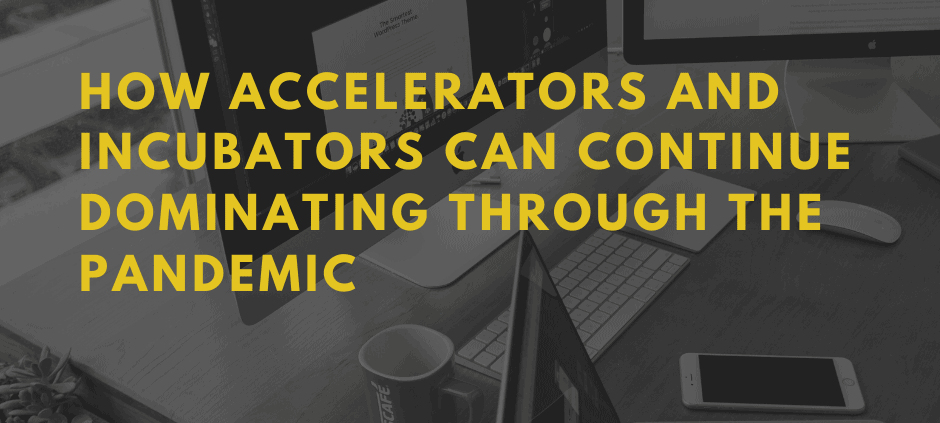How Accelerators And Incubators Can Continue Dominating Through The Pandemic
There is a lot of negativity in the world today, so let’s focus instead on the potential for positives within a crisis. One area that we could refer to here is in entrepreneurs, and that all-important development of new business. Ignoring setbacks, the digital age has boosted so much of what we had come to expect with businesses online. So how can entrepreneurs adapt to change? Within that question, how will accelerators and incubators continue to grow? We can find answers to these and more in looking at a bit of the background into how the situation has come to be.
Accelerator and Incubator hubs, the background
While talking about accelerators and incubators specifically, it’s worth starting off by answering a few of the following points,
- Where did they first come about?
- What is the clear difference between accelerators and incubators, broadly speaking?
- What were the first examples of both?
Basically, accelerators date from the digital age of 2005, as Megan Smith, the former Google business development Vice president, then remarked that;
“Accelerator programs appear to be addressing a growing opportunity in the market for innovation. A market that is rapidly changing, in part as a result of technologies that this sector has already created. They are an idea whose time has come’’
Y Combinator is seen as the world’s leading innovator where it comes to this subject, with a year on year growth following in its footsteps. TechStars and 500 start-ups followed suit as some of the most successful examples of accelerators.
Incubators, on the other hand, can be dated back much further in time to when the US economy was in a state of disarray in the 1970s. As would be expected, they are more traditional in terms of a business model and often government-funded.
Both provide examples of opportunity for those looking for investment, while also providing new ideas to entrepreneurs along the way. Other notable organisations that are attempting to add more cohorts in the market include StartupBoost, Sweden’s UBI Global, and Silicon Vikings from the Nordic region.
The current status in the midst of the pandemic, and the path forward
Y Combinator’s CEO is Michael Seibel, a man that is always worth listening to in business.
As he remarks from a recent UBI global publication; (while) ‘‘the pandemic limits the greatest advantage accelerators have-in networking, ENTREPRENEURS WILL ALWAYS FIND A WAY’
Currently, accelerators are being forced to work remotely. Y Combinator usually forbids the companies from joining their program without relocating. ‘We’d always prefer situations where our investors and founders get to interact in person’ Seibel agrees, noting that meeting people over a zoom conference call is not the same as being present at an intimate dinner surrounded by investors.
Ryan Kuder, the managing director of TechStars Anywhere, remarks on something similar about their remote accelerator program ‘There’s a tradeoff between the intimacy of in-person contact and the flexibility of being online. Our founders have a ton of flexibility, and it creates these networks of investors that aren’t as regionalized’.
Acknowledging that so much has changed in the world of entrepreneurs, there are different approaches to success. Yet each of these would still have the same ingredients, for example:
- A great business plan
- Hard-working staff and a focused team
- Funding
Additionally, collaboration software has changed the way of the world. ‘Co-locating’ had become an important point for many business functions to date because of the collaborative benefits. Before the pandemic, managers had thought of centralizing and sharing services, but following the events of 2020, the idea of virtual rather than physical centralization has come to the fore. Now we are seeing far more flexible models emerging in terms of sharing resources across teams and markets globally.
Michael Seibel adds to this point of discussion on the future aspect;
“I expect that the founders will adjust to the new world”
What next for the future of accelerators and incubators?
KAUST (The King Abdullah University of Science and Technology) have worked with us at Submit in implementing the innovation portal. That case study and more information can be read here-https://www.kaust.edu.sa/en/innovate
They have planned with and nurtured a number of future entrepreneurs, and they hope to maximise this level of output. Each year sees more and more applications, with a cohort of 20 in 2019 expanding to 100 in 2020, and rapid growth in their approach that ensures a lot of happy business students. There are a lot of unicorn success stories available on their website, and the higher intake overall has nurtured far more entrepreneurs than could ever have been expected in recent times.
If I asked you to take a guess as to which of the best minds from these kinds of start-ups would be running the next cohort, what would you say? Whether that is something chosen by TechStars, Y Combinator or KAUST, it could be anytime in the not so distant future.
The university has been teaching students the survival skills necessary to compete at the highest level in terms of being a competitive business. The ideas that are presented will help in the creation of jobs too and goes towards making sure research and development remains high in the region.
With an expected global recession to follow in the short-term future, this will be key for all accelerators and incubators, as well as combating or addressing some of the following:
- Preparation for crisis -This is essential, with an increased pressure on accelerators to prep startups with the challenges ahead of them.
- Economic Climate for innovation- with this being unfavourable, it’s important to remain engaged in a response to the crisis and the uncertainty which will follow the markets.
‘’When markets are gridlocked, startups are forced into what is known as “plateau patterned growth” (Bush et al., 2009, p. 489)
- Crisis Management; which would refer to the resilience necessary in entrepreneurial circles. How a company can continue functioning through a disruptive event is testament to this.
What can be done differently in an approach to innovation?
This question leads us on to the stage of what is next in terms of development and innovation. The funding aspect is key, as it opens the possibility of investment to anyone and not just at a regionalised basis. We can look at this in a quick view.
- Boost firms funding and investor opportunities; By gathering capital through internal measures and applying for government support.
- Boost Entrepreneurial Potential; By promoting university-business collaborations to facilitate industry applications of innovation and university-to-entrepreneurship transitions
- Online streams and pitches; although it may seem restrictive to investors, it actually allows even more investors to view the presentation. Michael Seibel of YC notes that their online demo day had “about 1,600 investors using their new site” and from this they “they generated about 18,000 introductions to our founders’. This could prove to be an opportunistic solution to gaining more attention from investors in the years to come.
There are, as mentioned above, many positive aspects to look to with the future of accelerators and incubators. Here at Submit, we like to facilitate that, in turn using a digital system which is both convenient and user friendly.
For more expanded detail on this, additional information can be seen here regarding our software. https://submit.com/accelerator-incubator-management-software/.
Don’t hesitate to get in touch for a free trial of a system that will make such a positive difference to working life of an entrepreneur!











